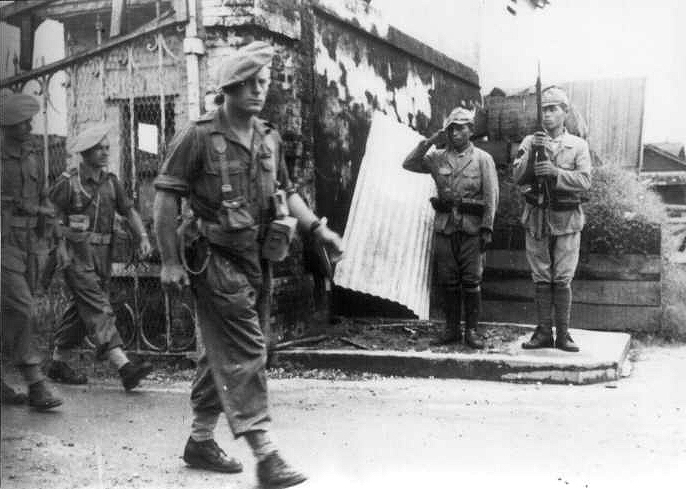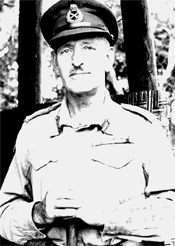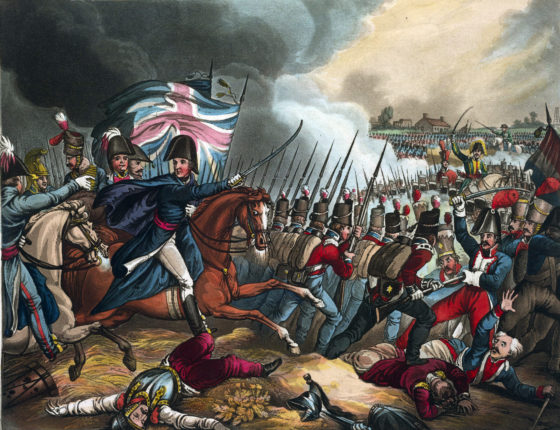
“British and Indian troops would become the first Allied soldiers to do battle with the Viet Minh, an insurgent army that would later go onto to vanquish the French and humble the United States.”
IN SEPTEMBER OF 1945 just after VJ Day, a brigade of 20,000 British and Indian troops landed in Saigon. The task force’s mission was three fold: to oversee the final surrender of the Japanese army in Indochina, to evacuate freed Allied POWs from the area and to maintain order until French administrators could resume control of the colony. Ideally, France would have led the mission, but with Western Europe still reeling from years of Nazi occupation, Paris was in no condition to launch such an operation. Instead, Allied planners turned to Great Britain to hold the line. [1]
To Maj. Gen. Douglas Gracey, the British commander of the Allied Land Forces Indochina (ALFIC), the deployment must have seemed like a welcome change from the years of bloody jungle fighting he’d overseen during the Burma campaign. Yet for the 51-year-old veteran of Britain’s Indian Army, the post war mission to Vietnam, code named Operation Masterdom, would quickly turn violent, becoming one of the most astonishing and little-known footnotes to the Second World War.
Gracey’s British and Indian troops would become the first Allied soldiers cross swords with the Vietnamese communists, an insurgent army that would later go onto to vanquish the French and humble the United States. Amazingly, the Anglo-Indo intervention force would fight with help not only from freed Allied and colonial POWs, but also rearmed Japanese soldiers who only weeks before had themselves been the enemy.

Opening Moves
When the British Indian stabilization force arrived in Saigon on Sept. 13, the city was anything but stable. Rioting and looting were rampant. Worse, communist guerrillas, known as the Viet Minh, had marched in immediately following Japan’s defeat and started slaughtering those deemed counter revolutionaries, collaborators or imperialists.
To make matters worse, Japanese troops throughout the region refused to lay down their arms in accordance with Tokyo’s surrender and continued to occupy their wartime strongholds. The former occupiers, surrounded by a hostile population and with no way to get home, remained vigilant for reprisals.
Gracey immediately declared martial law. His forces fanned out across the city forcing out the Viet Minh to make room for the returning French administrators. He even went so far as to deputize the remaining Japanese troops to help his troops restore order. [2] A series of bloody clashes with the communists ensued. But by Sept. 23, French authorities had reestablished their administration of the city, under the protection of the British and Indians. French and colonial POWs were rearmed and formed into regiments to help with the security. Order was restored. Or was it?

Shots Fired
Things were unfolding largely according to plan until Sept. 25. That’s when the communists struck back.
Unwilling to trade Japanese occupiers for Europeans, the Viet Minh kicked off a fresh guerrilla war against the French authorities and their British protectors.
Insurgent attacks broke out all across Saigon. The guerrillas even launched a raid against British troops at Tan Son Nhut airport where Viet Minh clashed with the defenders in a pre-dawn assault, losing six men in the process. One British Gurkha was killed in the encounter. It was only the beginning. More attacks would follow in the coming days.
For the most part, British and Indian troops, fresh from fighting the Japanese in Burma made short work of the rag-tag guerrillas. Allied casualties were light, however the communists were taking a pounding.
By early October, the Viet Minh had agreed with Gracey to a ceasefire. It was soon broken. On Oct. 10, the communists massacred a detachment of British engineers in one raid. It was a stunning escalation.

More Troops Arrive
With the security situation deteriorating rapidly, the British brought in reinforcements: The 32nd Infantry Brigade and an Indian light armour regiment joined the mission. And as long as the Viet Minh attacks were preventing the British from the orderly repatriation of the remnants of the Japanese army, Gracey continued to rely on them for assistance. [3]
As it would turn out, he’d need all the help he could get.
On Oct. 13, the insurgents unleashed a fresh series of raids on targets in an around Saigon. Again, they were repelled by British, Indian, French colonial and even Japanese troops. An estimated 500 Viet Minh were killed in this newest round of attacks. [4]

The Allies, recognizing the need to regain the initiative, went on the offensive. By the end of October, Gracey organized an operation to clear a ring of insurgents from around the city. The mission to lift the siege would include Indian infantry, artillery and armour, as well as a battalion of Japanese troops. The combined operation killed more than 200 insurgents. [5] Allied losses were minimal.
Sporadic clashes would continue throughout November and December in the central highlands north of Saigon.
The largest encounter of the Anglo Indian foray in Vietnam occurred on Jan. 3, 1946, 40 kilometres north east of Saigon at Bien Hoa. Nearly 1,000 communist guerrillas launched an assault on a British and Indian stronghold there, but were repulsed in a firefight that lasted the entire night. Nearly 100 insurgents were mowed down by machine gun fire without the loss of a single Allied soldier.

Passing the Torch
As the winter wore on, British forces were gradually withdrawn and the French military took over security. The Japanese soldiers were also disarmed and sent home. By May, the last of the Indian and British combat troops had departed bringing Operation Masterdom to a close.
From that point on and until 1954, the war in Vietnam would be an exclusively French colonial conflict.
For their part, the British lost 40 troops. Japanese and French casualties were roughly equal to that. The Viet Minh had suffered more than 2,500 dead. [6] They would be the first the fall. Over the next 30 years, more than 2 million would die in the intractable and tragic war that engulfed all of Indochina.










Good one! Being a wargamermthis might be the onemthing that might get me to do something about WWII (in the wider sense) in Asia one day!
Glad you liked it. I didn’t even realize this brief conflict occurred until I began reading about it. This by the way is the best part of running this blog — I end up learning new things.
There’s a good reason you never heard about thid, Ho Chi Minh was a U.S. ally then, begging to make Vietnam a U.S. Protectorate. Interesting the British mandate was created at Potsdam, Stalin, chairing tge conference, showing no interest in Vietnam, handing it over to the Brits and Chinese, only observers at the conference. In return for England putting France back in tge drivers seat France gave England Syria. And besides England rearming Japanese against America’s ally, the French spearheaded their assault with German Nazi’s recruited from European camps. General McArthur referred to this treachery against a U.S. ally “the most ignoble kind of betrayal against the people we promised to liberate”. In the end the U.S. got what it desreved. Vietnam, and remains, a lie
I had to go to Vietnam.Class of ‘`68. We did not like the ARVINs at all and I actually grew to respect the VC (until we exterminated then during the TET offensive). A few years after I got out of the army I realized we should have gone to Vietnam, but we were on the wrong side. It is Uncle HO we should have been supporting against the French. All they wanted was their own country,,,,just like us. …. They would make a great ally for the US against China. – And for the record Vietnam seems to like communism, and has no desire to spread it so that is their business and not ours.